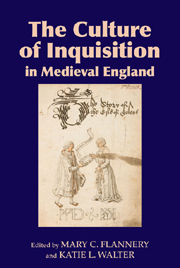Book contents
- Frontmatter
- Contents
- Illustrations
- List of Contributors
- Acknowledgements
- Abbreviations
- Introduction: Imagining Inquisition
- 1 Inquisition, Public Fame and Confession: General Rules and English Practice
- 2 The Imperatives of Denunciatio: Disclosing Others' Sins to Disciplinary Authorities
- 3 English Provincial Constitutions and Inquisition into Lollardy
- 4 The Contest over the Public Imagination of Inquisition, 1380–1430
- 5 ‘Vttirli Onknowe’? Modes of Inquiry and the Dynamics of Interiority in Vernacular Literature
- 6 From Defacement to Restoration: Inquisition, Confession and Thomas Usk's Appeal and Testament of Love
- 7 Confession, Inquisition and Exemplarity in The Erle of Tolous and Other Middle English Romances
- 8 Heresy Inquisition and Authorship, 1400–1560
- 9 Imitating Inquisition: Dialectical Bias in Protestant Prison Writings
- 10 Response Essay: Chaucer's Inquisition
- Bibliography
- Index
6 - From Defacement to Restoration: Inquisition, Confession and Thomas Usk's Appeal and Testament of Love
Published online by Cambridge University Press: 05 April 2013
- Frontmatter
- Contents
- Illustrations
- List of Contributors
- Acknowledgements
- Abbreviations
- Introduction: Imagining Inquisition
- 1 Inquisition, Public Fame and Confession: General Rules and English Practice
- 2 The Imperatives of Denunciatio: Disclosing Others' Sins to Disciplinary Authorities
- 3 English Provincial Constitutions and Inquisition into Lollardy
- 4 The Contest over the Public Imagination of Inquisition, 1380–1430
- 5 ‘Vttirli Onknowe’? Modes of Inquiry and the Dynamics of Interiority in Vernacular Literature
- 6 From Defacement to Restoration: Inquisition, Confession and Thomas Usk's Appeal and Testament of Love
- 7 Confession, Inquisition and Exemplarity in The Erle of Tolous and Other Middle English Romances
- 8 Heresy Inquisition and Authorship, 1400–1560
- 9 Imitating Inquisition: Dialectical Bias in Protestant Prison Writings
- 10 Response Essay: Chaucer's Inquisition
- Bibliography
- Index
Summary
Dealing with stories and silence—words recovered and words lost to death.
John H. Arnold, Inquisition and PowerAt the heart of confession lies the promise of effacement: through the processes of contrition, confession, absolution and penance, an individual's sins are purged for eternity. This tenet was illustrated in a popular exemplum that circulated in penitential manuals and florilegia across Europe during the thirteenth and fourteenth centuries. In this exemplum, a scholar pays a visit to his local abbot to make his confession. Overcome with contrition and shame, the scholar is unable to speak a single word, so the abbot enjoins him to write down his sins instead. Horrified upon reading the unspeakable deeds in print, however, the abbot summons the prior for support. But when the prior arrives, everyone discovers that the scholar's sins have been miraculously erased from the page. Technically, the story is incomplete: formal absolution, one of the elements of a full confession, never takes place. But by omitting the priest's intermediary role, the narrative presents an argument for the sacramental validity of the scholar's written performance of confession, the contents of which only God (and not even the reader) knows.
- Type
- Chapter
- Information
- The Culture of Inquisition in Medieval England , pp. 94 - 111Publisher: Boydell & BrewerPrint publication year: 2013



